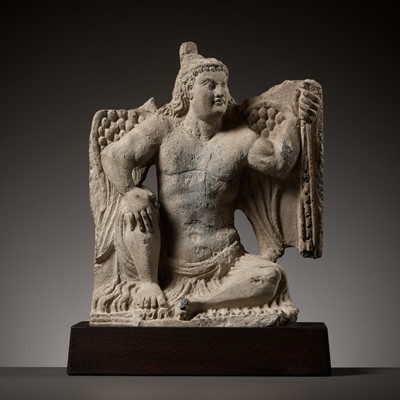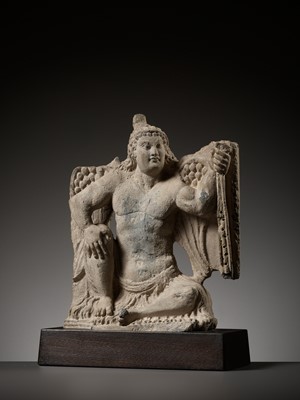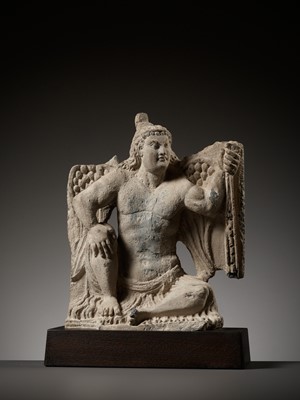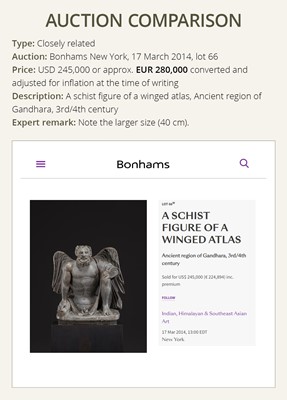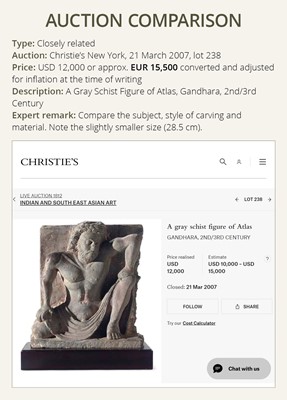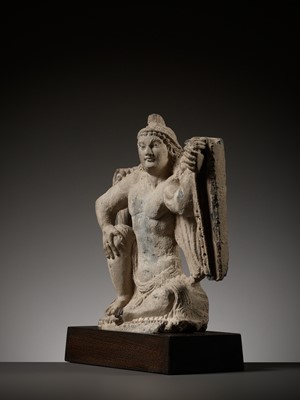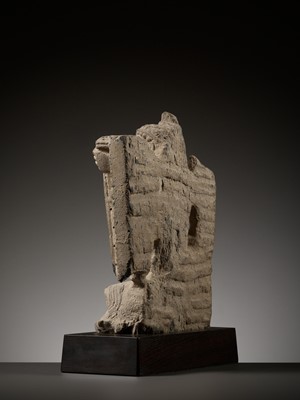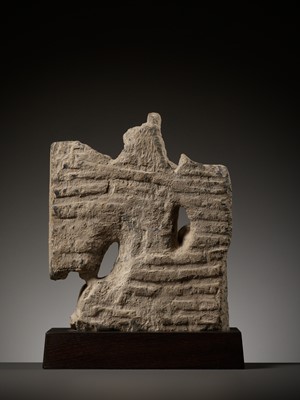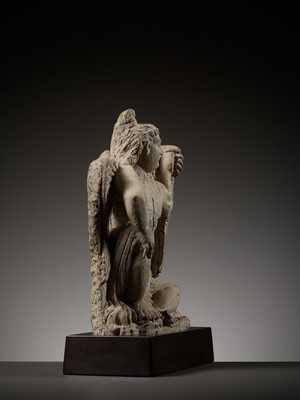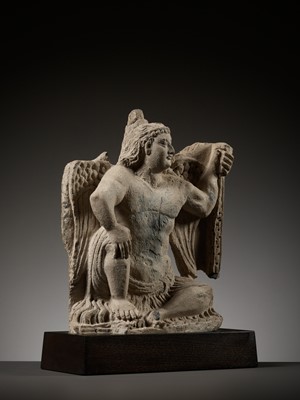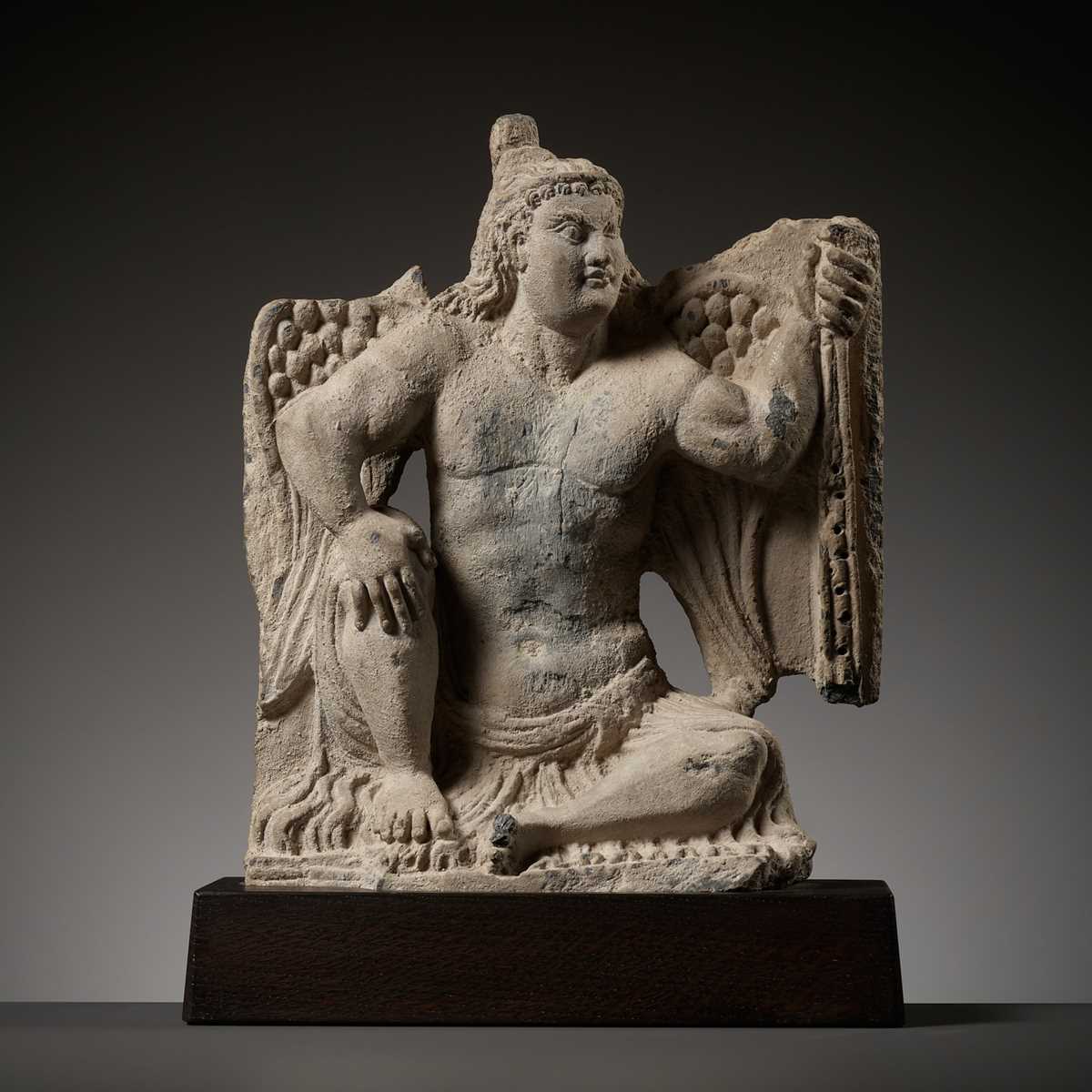2nd Jun, 2023 11:00
Fine Chinese Art / 中國藝術集珍 / Buddhism & Hinduism
181
A GRAY SCHIST FIGURE OF A WINGED ATLAS, ANCIENT REGION OF GANDHARA, 3RD - 4TH CENTURY
西元三至四世紀犍陀羅灰色片岩阿特拉斯像
Sold for €9,100
including Buyer's Premium
The atlant squats with his right leg raised, his toes outstretched, his right hand resting on his knee and his left still holding part of the superstructure which was originally located above him. His face superbly carved with almond-shaped eyes below bushy furrowed brows and full bow-shaped lips, framed by thick tufts of hair, flanked by his large wings.
Provenance: An old private collection in France. Acher Eskenasy, Paris, France, acquired from the above in 2001. LP Collection Paris, France, acquired from the above. Acher Eskenasy is a noted French scholar and collector of Asian and tribal art. Major works previously owned by him are now in important collections and museums, such as the Metropolitan Museum of Art in New York and the Musée du Quai Branly in Paris.
Condition: Good condition, commensurate with age. Extensive wear, losses, nicks, scratches, structural cracks, signs of weathering and erosion, encrustations. With an old sand-colored pigment coating.
Weight: 8,241 g (incl. stand)
Dimensions: Height 30.5 cm (excl. stand) and 35.5 cm (incl. stand)
With a fitted wood stand. (2)
Only a few sculptures communicate so clearly the classical legacy in Gandharan art. His mature, bushy face recalls the portraits of Greek and Roman gods and leaders, while his Herculean musculature evokes the athletic ideal. Furthermore, the atlant type stems from a tradition in classical architecture of depicting male and female figures supporting architectural superstructures best known from The Ten Books on Architecture by Vitruvius, dedicated to Emperor Augustus (see Rowland, Vitruvius: Ten Books on Architecture, Cambridge, 1999, pages 83 and 135).
In the Gandharan context, similar examples in stucco surviving in situ line the veneer of stupa bases at Taxila and Hadda, recording the placement of such figures at Buddhist sites. Whilst maintaining a similar function and a clearly Western look, the Gandharan version differs from the classical prototype in the common inclusion of wings and the primarily ornamental rather than architectural function of the figure. Moreover, while we have evidence from which to understand his context at Buddhist sites, his precise identity remains a mystery. He has been called a disguised yaksha, a lesser Greek god, and a Garuda, yet there is no archaeological or textual foundation to underpin any of these claims (see Foucher, L’art Gréco-Bouddhique du Gandhara, 1905, page 208, and Errington, The Western Discovery of the Art of Gandhara and the Finds of Jamalgarhi, London, 1987, page 67). Perhaps, the term “Atlas” ties him too closely to the classical prototypes, at the risk of obscuring added layers of meaning in the unique Gandharan context.
Literature comparison:
For a further discussion of winged Atlas figures from Gandhara, see P. Pal, Asian Art at the Norton Simon Museum, vol. 1, fig. 35, p. 68. For similar examples of winged “Atlas” figures, see W. Zwalf, A Catalogue of the Gandhara Sculpture at the British Museum, 1996, pp. 206-211, fig. 355-368. Two other examples survive in the Claude de Marteau collection in Brussels and the Peshawar Museum (see Kurita, Gandharan Art, vol. II, Tokyo, 1990, figs. 448 & 453, pp. 155 & 157).
Auction result comparison:
Type: Closely related
Auction: Bonhams New York, 17 March 2014, lot 66
Price: USD 245,000 or approx. EUR 280,000 converted and adjusted for inflation at the time of writing
Description: A schist figure of a winged atlas, Ancient region of Gandhara, 3rd/4th century
Expert remark: Note the larger size (40 cm).
Auction result comparison:
Type: Closely related
Auction: Christie’s New York, 21 March 2007, lot 238
Price: USD 12,000 or approx. EUR 15,500 converted and adjusted for inflation at the time of writing
Description: A Gray Schist Figure of Atlas, Gandhara, 2nd/3rd Century
Expert remark: Compare the subject, style of carving and material. Note the slightly smaller size (28.5 cm).
西元三至四世紀犍陀羅灰色片岩阿特拉斯像
阿特拉斯像雕刻逼真、雄偉有力,呈坐姿,右腿半力,右手撐在膝蓋上,左腿彎曲,肩膀後面張開翅膀;臉龐刻畫細緻,雙眉濃密,大眼圓睜,嘴唇豐滿,長髮披肩。
來源:法國私人舊藏;巴黎Acher Eskenasy收藏,2001年購於上述收藏;法國巴黎LP Collection 收藏,購於上述收藏。Acher Eskenasy是一位著名的法國學者和亞洲及部落藝術收藏家。他以前擁有的主要藏品現在被重要的收藏和博物館收藏,例如紐約的大都會藝術博物館和巴黎凱布朗利博物館。
品相:條件良好,大面積磨損、缺損、刻痕、劃痕、結構裂縫、風化和結殼,帶有沙色顏料塗層。
重量:8,241 克 (含底座)
尺寸:高 30.5 厘米 (不含底座) 與35.5 厘米 (含底座)
木底座。(2)
很少有雕塑能如此清晰地傳達出犍陀羅藝術中的古典意義。他成熟的臉讓人想起希臘和羅馬的神靈和領袖的肖像,而他強壯的肌肉則喚起了運動員的理想。此外,阿特拉斯類型雕塑源於古典建築中支持建築上層建築。最著名的是維特魯威獻給奧古斯都皇帝的十本建築書籍 (見Rowland,Vitruvius: Ten Books on Architecture,康橋,1999年,第83和135頁)。
在犍陀羅時期,在塔西拉和哈達的佛塔基地的飾面上,在原地倖存的灰泥中有類似的例子,記錄了這些人物在佛教遺址中的位置。雖然保持了相似的功能和明顯的西方外觀,但犍陀羅版本與經典原型的不同之處在於翅膀以及人物的主要裝飾功能而非建築功能。 此外,雖然我們有證據可以瞭解他在佛教遺址的背景,但他的確切身份仍然是個謎。 他被稱為夜叉、小希臘神和迦樓羅,但沒有考古學或文字基礎支持任何這些說法(參見 Foucher,L'art Gréco-Bouddhique du Gandhara,1905年,第208頁;見Errington,The Western Discovery of the Art of Gandhara和the Finds of Jamalgarhi,倫敦,1987 年,第 67 頁)。 或許,“阿特拉斯”一詞將他與經典原型聯繫得太緊密,有可能在獨特的犍陀羅語境中會掩蓋附加意義。
文獻比較:
關於犍陀羅阿特拉斯像進階討論,見P. Pal, ,《Asian Art at the Norton Simon Museum》,卷1,圖35,頁68。一件相似的阿特拉斯像,見W. Zwalf,《A Catalogue of the Gandhara Sculpture at the British Museum》,1996年,頁206-211,圖355-368。兩件例子現存於布魯塞爾的Claude de Marteau collection和白沙瓦博物館(見Kurita,Gandharan Art,卷II,東京,1990年,圖448和453,頁155和157)。
拍賣結果比較:
形制:非常相近
拍賣:紐約邦瀚斯,2014年3月17日,lot 66
價格:USD 245,000(相當於今日EUR 280,000)
描述:西元三至四世紀犍陀羅灰色片岩阿特拉斯像
專家評論:請注意尺寸較大(40 厘米)。
拍賣結果比較:
形制:非常相近
拍賣:紐約佳士得,2007年3月21日,lot 238
價格:USD 12,000(相當於今日EUR 15,500)
描述:西元二至三世紀犍陀羅灰色片岩阿特拉斯像
專家評論:比較主題、雕刻風格和材料。請注意尺寸稍小(28.5 厘米)。
The atlant squats with his right leg raised, his toes outstretched, his right hand resting on his knee and his left still holding part of the superstructure which was originally located above him. His face superbly carved with almond-shaped eyes below bushy furrowed brows and full bow-shaped lips, framed by thick tufts of hair, flanked by his large wings.
Provenance: An old private collection in France. Acher Eskenasy, Paris, France, acquired from the above in 2001. LP Collection Paris, France, acquired from the above. Acher Eskenasy is a noted French scholar and collector of Asian and tribal art. Major works previously owned by him are now in important collections and museums, such as the Metropolitan Museum of Art in New York and the Musée du Quai Branly in Paris.
Condition: Good condition, commensurate with age. Extensive wear, losses, nicks, scratches, structural cracks, signs of weathering and erosion, encrustations. With an old sand-colored pigment coating.
Weight: 8,241 g (incl. stand)
Dimensions: Height 30.5 cm (excl. stand) and 35.5 cm (incl. stand)
With a fitted wood stand. (2)
Only a few sculptures communicate so clearly the classical legacy in Gandharan art. His mature, bushy face recalls the portraits of Greek and Roman gods and leaders, while his Herculean musculature evokes the athletic ideal. Furthermore, the atlant type stems from a tradition in classical architecture of depicting male and female figures supporting architectural superstructures best known from The Ten Books on Architecture by Vitruvius, dedicated to Emperor Augustus (see Rowland, Vitruvius: Ten Books on Architecture, Cambridge, 1999, pages 83 and 135).
In the Gandharan context, similar examples in stucco surviving in situ line the veneer of stupa bases at Taxila and Hadda, recording the placement of such figures at Buddhist sites. Whilst maintaining a similar function and a clearly Western look, the Gandharan version differs from the classical prototype in the common inclusion of wings and the primarily ornamental rather than architectural function of the figure. Moreover, while we have evidence from which to understand his context at Buddhist sites, his precise identity remains a mystery. He has been called a disguised yaksha, a lesser Greek god, and a Garuda, yet there is no archaeological or textual foundation to underpin any of these claims (see Foucher, L’art Gréco-Bouddhique du Gandhara, 1905, page 208, and Errington, The Western Discovery of the Art of Gandhara and the Finds of Jamalgarhi, London, 1987, page 67). Perhaps, the term “Atlas” ties him too closely to the classical prototypes, at the risk of obscuring added layers of meaning in the unique Gandharan context.
Literature comparison:
For a further discussion of winged Atlas figures from Gandhara, see P. Pal, Asian Art at the Norton Simon Museum, vol. 1, fig. 35, p. 68. For similar examples of winged “Atlas” figures, see W. Zwalf, A Catalogue of the Gandhara Sculpture at the British Museum, 1996, pp. 206-211, fig. 355-368. Two other examples survive in the Claude de Marteau collection in Brussels and the Peshawar Museum (see Kurita, Gandharan Art, vol. II, Tokyo, 1990, figs. 448 & 453, pp. 155 & 157).
Auction result comparison:
Type: Closely related
Auction: Bonhams New York, 17 March 2014, lot 66
Price: USD 245,000 or approx. EUR 280,000 converted and adjusted for inflation at the time of writing
Description: A schist figure of a winged atlas, Ancient region of Gandhara, 3rd/4th century
Expert remark: Note the larger size (40 cm).
Auction result comparison:
Type: Closely related
Auction: Christie’s New York, 21 March 2007, lot 238
Price: USD 12,000 or approx. EUR 15,500 converted and adjusted for inflation at the time of writing
Description: A Gray Schist Figure of Atlas, Gandhara, 2nd/3rd Century
Expert remark: Compare the subject, style of carving and material. Note the slightly smaller size (28.5 cm).
西元三至四世紀犍陀羅灰色片岩阿特拉斯像
阿特拉斯像雕刻逼真、雄偉有力,呈坐姿,右腿半力,右手撐在膝蓋上,左腿彎曲,肩膀後面張開翅膀;臉龐刻畫細緻,雙眉濃密,大眼圓睜,嘴唇豐滿,長髮披肩。
來源:法國私人舊藏;巴黎Acher Eskenasy收藏,2001年購於上述收藏;法國巴黎LP Collection 收藏,購於上述收藏。Acher Eskenasy是一位著名的法國學者和亞洲及部落藝術收藏家。他以前擁有的主要藏品現在被重要的收藏和博物館收藏,例如紐約的大都會藝術博物館和巴黎凱布朗利博物館。
品相:條件良好,大面積磨損、缺損、刻痕、劃痕、結構裂縫、風化和結殼,帶有沙色顏料塗層。
重量:8,241 克 (含底座)
尺寸:高 30.5 厘米 (不含底座) 與35.5 厘米 (含底座)
木底座。(2)
很少有雕塑能如此清晰地傳達出犍陀羅藝術中的古典意義。他成熟的臉讓人想起希臘和羅馬的神靈和領袖的肖像,而他強壯的肌肉則喚起了運動員的理想。此外,阿特拉斯類型雕塑源於古典建築中支持建築上層建築。最著名的是維特魯威獻給奧古斯都皇帝的十本建築書籍 (見Rowland,Vitruvius: Ten Books on Architecture,康橋,1999年,第83和135頁)。
在犍陀羅時期,在塔西拉和哈達的佛塔基地的飾面上,在原地倖存的灰泥中有類似的例子,記錄了這些人物在佛教遺址中的位置。雖然保持了相似的功能和明顯的西方外觀,但犍陀羅版本與經典原型的不同之處在於翅膀以及人物的主要裝飾功能而非建築功能。 此外,雖然我們有證據可以瞭解他在佛教遺址的背景,但他的確切身份仍然是個謎。 他被稱為夜叉、小希臘神和迦樓羅,但沒有考古學或文字基礎支持任何這些說法(參見 Foucher,L'art Gréco-Bouddhique du Gandhara,1905年,第208頁;見Errington,The Western Discovery of the Art of Gandhara和the Finds of Jamalgarhi,倫敦,1987 年,第 67 頁)。 或許,“阿特拉斯”一詞將他與經典原型聯繫得太緊密,有可能在獨特的犍陀羅語境中會掩蓋附加意義。
文獻比較:
關於犍陀羅阿特拉斯像進階討論,見P. Pal, ,《Asian Art at the Norton Simon Museum》,卷1,圖35,頁68。一件相似的阿特拉斯像,見W. Zwalf,《A Catalogue of the Gandhara Sculpture at the British Museum》,1996年,頁206-211,圖355-368。兩件例子現存於布魯塞爾的Claude de Marteau collection和白沙瓦博物館(見Kurita,Gandharan Art,卷II,東京,1990年,圖448和453,頁155和157)。
拍賣結果比較:
形制:非常相近
拍賣:紐約邦瀚斯,2014年3月17日,lot 66
價格:USD 245,000(相當於今日EUR 280,000)
描述:西元三至四世紀犍陀羅灰色片岩阿特拉斯像
專家評論:請注意尺寸較大(40 厘米)。
拍賣結果比較:
形制:非常相近
拍賣:紐約佳士得,2007年3月21日,lot 238
價格:USD 12,000(相當於今日EUR 15,500)
描述:西元二至三世紀犍陀羅灰色片岩阿特拉斯像
專家評論:比較主題、雕刻風格和材料。請注意尺寸稍小(28.5 厘米)。
Zacke Live Online Bidding
Our online bidding platform makes it easier than ever to bid in our auctions! When you bid through our website, you can take advantage of our premium buyer's terms without incurring any additional online bidding surcharges.
To bid live online, you'll need to create an online account. Once your account is created and your identity is verified, you can register to bid in an auction up to 12 hours before the auction begins.
Intended Spend and Bid Limits
When you register to bid in an online auction, you will need to share your intended maximum spending budget for the auction. We will then review your intended spend and set a bid limit for you. Once you have pre-registered for a live online auction, you can see your intended spend and bid limit by going to 'Account Settings' and clicking on 'Live Bidding Registrations'.
Your bid limit will be the maximum amount you can bid during the auction. Your bid limit is for the hammer price and is not affected by the buyer’s premium and VAT. For example, if you have a bid limit of €1,000 and place two winning bids for €300 and €200, then you will only be able to bid €500 for the rest of the auction. If you try to place a bid that is higher than €500, you will not be able to do so.
Online Absentee and Telephone Bids
You can now leave absentee and telephone bids on our website!
Absentee Bidding
Once you've created an account and your identity is verified, you can leave your absentee bid directly on the lot page. We will contact you when your bids have been confirmed.
Telephone Bidding
Once you've created an account and your identity is verified, you can leave telephone bids online. We will contact you when your bids have been confirmed.
Classic Absentee and Telephone Bidding Form
You can still submit absentee and telephone bids by email or fax if you prefer. Simply fill out the Absentee Bidding/Telephone bidding form and return it to us by email at office@zacke.at or by fax at +43 (1) 532 04 52 20. You can download the PDF from our Upcoming Auctions page.
How-To Guides
How to Create Your Personal Zacke Account
How to Register to Bid on Zacke Live
How to Leave Absentee Bids Online
How to Leave Telephone Bids Online
中文版本的操作指南
创建新账号
注册Zacke Live在线直播竞拍(免平台费)
缺席投标和电话投标
Third-Party Bidding
We partner with best-in-class third-party partners to make it easy for you to bid online in the channel of your choice. Please note that if you bid with one of our third-party online partners, then there will be a live bidding surcharge on top of your final purchase price. You can find all of our fees here. Here's a full list of our third-party partners:
- 51 Bid Live
- EpaiLive
- ArtFoxLive
- Invaluable
- LiveAuctioneers
- the-saleroom
- lot-tissimo
- Drouot
Please note that we place different auctions on different platforms. For example, in general, we only place Chinese art auctions on 51 Bid Live.
Bidding in Person
You must register to bid in person and will be assigned a paddle at the auction. Please contact us at office@zacke.at or +43 (1) 532 04 52 for the latest local health and safety guidelines.
